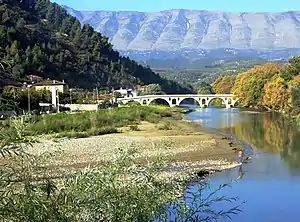Osum
The Osum is a river in southern Albania, one of the source rivers of the Seman. It is 161 km (100 mi) long and its drainage basin is 2,073 km2 (800 sq mi). Its average discharge is 32.5 m3/s (1,150 cu ft/s).[1] Its source is in the southwestern part of the Korçë County, near the village Vithkuq at an altitude of 1,050 metres (3,440 ft). It flows initially south to the Kolonjë municipality, then west to Çepan, and northwest through Çorovodë where it flows through the famous Osum Canyon, Poliçan, Berat and Urë Vajgurore. It joins the Devoll near Kuçovë, to form the Seman. The discharge of the river is reported to vary between 5.11 m3 (180 cu ft)/s and 74.11 m3 (2,617 cu ft)/s.
| Osum | |
|---|---|
 Osumi overlooking the Gorica Bridge | |
| Location | |
| Country | Albania |
| Physical characteristics | |
| Source | |
| • location | Western Vithkuq |
| • coordinates | 40°32′10″N 20°29′29″E |
| • elevation | 1,420 m (4,660 ft) |
| Mouth | |
• location | Seman near Kuçovë |
• coordinates | 40.8128°N 19.8588°E |
| Length | 161 km (100 mi) |
| Basin size | 2,073 km2 (800 sq mi) |
| Discharge | |
| • average | 32.5 m3/s (1,150 cu ft/s) |
| Basin features | |
| Progression | Seman→ Adriatic Sea |
Name
In classical antiquity, the Osum river was known as the Apsus, which is a derivative of the Indo-European root *ăp- "water, river". The contemporary Albanian name Osum (definite form: Osumi), which is used to indicate the upper course of the river, evolved from *Apsōn(em) through Bulgarian phonetic changes. In Bulgaria there is a river with the same name origin - Osam. Also the contemporary Albanian name Seman/Semen (definite form: Semani/Semeni), which is used to indicate the lower course of the river, evolved from *Apson-, but through Albanian phonetic changes.[2]
References
- Cullaj, A.; Hasko, A.; Miho, A.; Schanz, F.; Brandl, H.; Bachofen, R. (2005). "The quality of Albanian natural waters and the human impact". Environment International. 31 (1): 138. doi:10.1016/j.envint.2004.06.008. PMID 15607787.
- Georgiev, Vladimir Ivanov (1981). Introduction to the History of the Indo-European Languages. Publishing House of the Bulgarian Academy of Sciences. p. 350. ISBN 978-953-51-7261-1.
